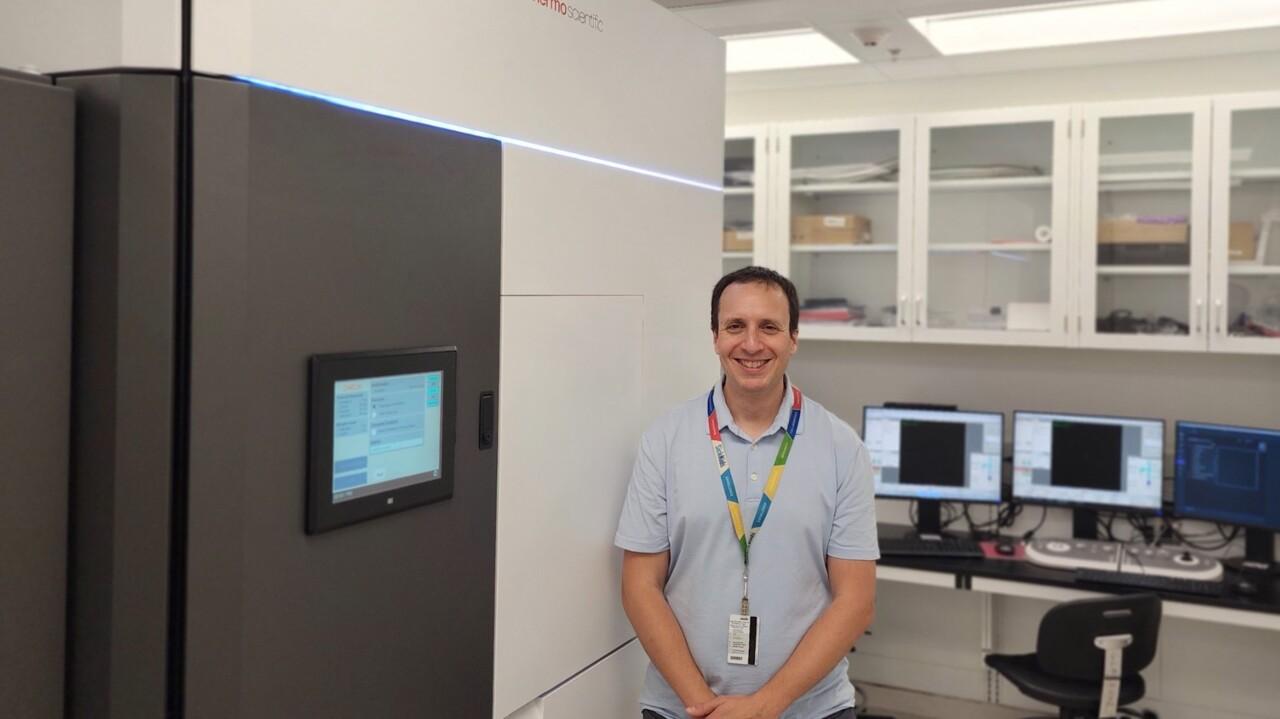Search Thermo Fisher Scientific

Flexible platform ideal for multiple cryo-TEM applications
The Thermo Scientific Glacios 2 Cryo-TEM offers structural biology labs a complete package for studying protein structures and delivers unique insights, supporting multiple applications including single-particle analysis, cryo-electron tomography (cryo-ET), and microcrystal electron diffraction (MicroED). With the Glacios 2 Cryo-TEM, configured with the Thermo Scientific Selectris X Imaging Filter and the Thermo Scientific Falcon 4i Direct Electron Detector, you can visually resolve protein structures and produce 3D reconstructions down to 1.6 Å.
High resolution single particle cryo-EM
With its high-resolution capabilities, the Glacios 2 Cryo-TEM is ideal for single particle analysis, enabling near-atomic structural determination of challenging proteins without the need for crystallization. Samples can be studied directly in solution. High-quality data collection is possible thanks to hardware improvements and the integration of innovative Thermo Scientific Smart EPU Software.
A reconstruction of CDK-activating kinase at 2.3 Å resolution from data collected over 22 hours using the Glacios 2 Cryo-TEM with the Falcon 4i Direct Electron Detector, Selectris X Imaging Filter, and FFI.
Molecular structures determined with the Glacios 2 Cryo-TEM
High throughput cryo-EM
The Glacios 2 Cryo-TEM couples high-resolution with high-throughput to provide valuable structural insights. The integrated Falcon 4i Direct Electron Detector provides better image quality than its predecessors in less time. To further enhance productivity and image quality, the Glacios 2 Cryo-TEM offers fringe-free imaging that eliminates fringes at the edge of the beam, a more stable stage, and faster automated data acquisition. Together, these improvements allow you to collect more images per foil hole and accelerate single particle analysis.
High throughput cryo-EM for drug discovery
Cryo-electron microscopy is rapidly drawing interest in structure-based drug discovery and design, since it can accurately and rapidly visualize to high resolutions the interactions between drug and receptor of a multitude of samples. The Glacios 2 Cryo-TEM can perform as a standalone tool for high resolution data collection, for example, CAK at 2.3 Å, but also serves as a powerful screening system that enhances subsequent 300 kV analysis. The Glacios 2 Cryo-TEM was used to determine over two dozen 3.5-4.5 Å kinase structures at ~1 structure per hour. This approach greatly improves throughput and productivity, optimizing the time spent on the higher-resolution Thermo Scientific Krios Cryo TEM and ensuring that the highest quality data is collected for only the most ideal samples. This methodology facilitates the application of cryo-EM to iterative structure-based drug design, which is becoming increasingly necessary to address a range of global health challenges.

Cryo-tomography
The Glacios 2 Cryo-TEM offers excellent cryo-electron tomography (cryo-ET) capabilities, providing nanometer-scale imaging of a cell’s interior in 3D and the visualization of protein complexes within their physiological environments. Using the Glacios 2 Cryo-TEM, tomography data can be obtained from whole bacterial cells or lamellae prepared with Thermo Scientific Aquilos, Arctis or Hydra Bio Cryo-focused ion beam (Cryo-FIB) instruments.
3D visualization of cell membrane, liposomes and filaments from the bacteria Magnetospirillum grypgiswaldense (courtesy of Dirk Schüler, Uni Bayreuth) using the Glacios 2 Cryo-TEM from a sample that was prepared with the Thermo Scientific Vitrobot Mark IV system. Data segmentation and visualization by Thermo Scientific Amira Software.
3D visualization of a Golgi apparatus from the green alga Chlamydomonas reinhardti using the Glacios 2 Cryo-TEM from a sample that was prepared with the Thermo Scientific Aquilos Cryo-FIB. Data segmentation and visualization by Thermo Scientific Amira Software.
Microcrystal electron diffraction
The structural determination of small molecules and proteins can be challenging using standard methods such as X-ray crystallography. The Glacios 2 Cryo-TEM enables fast, high-resolution imaging using microcrystal electron diffraction (microED), where atomic details can be extracted from individual nanocrystals (<200 nm in size), even in a heterogeneous mixture. The Glacios 2 Cryo-TEM can be paired with the Thermo Scientific CETA-D Camera and the Thermo Scientific MicroED Package for a complete solution for MicroED.
The MicroED Package comprises all necessary elements to use the Glacios 2 Cryo-TEM for MicroED applications.
- Thermo Scientific EPU-D Software for screening and automated data acquisition. Coordinating the screening of crystals and diffraction, and data collection itself, can be overwhelming and time-consuming when done manually. EPU-D Software offers ease of use in a user-friendly environment. For example, it enables quick switching between imaging and diffraction, it guides optimal low-dose setup, and drives the constant speed continuous tilt for data collection. EPU-D Software now expands the intuitive capabilities and unified user experience of EPU Software to the electron crystallography domain.
- Optimized smaller beam stop to mask the central beam without blocking low-resolution diffraction spots.
- Optimized aperture set so that unwanted background signal from the area surrounding the crystal can be maximally suppressed.
- Set of dedicated electron-optical settings to enable optimal camera utilization while benefiting from best sample-beam geometry.
For Research Use Only. Not for use in diagnostic procedures.





